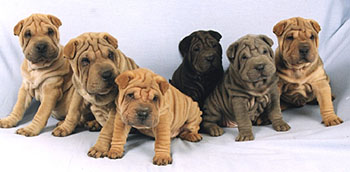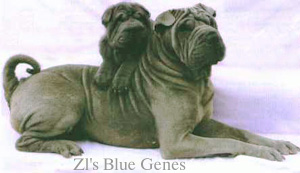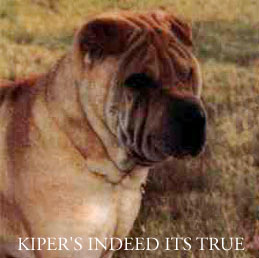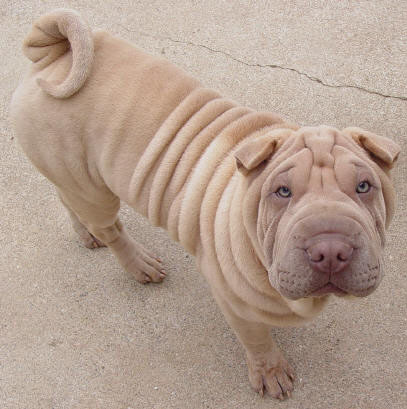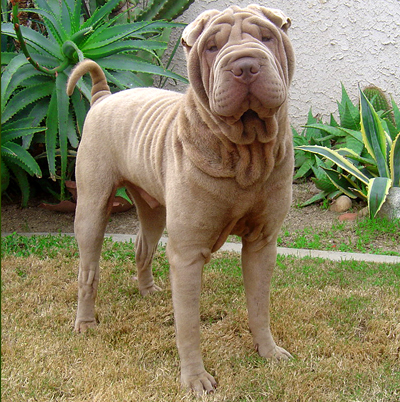About Blue Sharpei
|
In 1985 Zella Llewellyn of Texas discovered an intriguing surprise in one of her litters...a blue horsecoat puppy she named Zl's Blue Genes. This dog, became a CSPCA Champion and is known as the first official Blue Shar-Pei in the breed. Blue Genes lived to be 12 years old. In researching his pedigree it was discovered that a line breeding between a particular pair produced this first blue. The only other original blue line was developed by the Deborah Kiper (Kipers Shar-Pei) from a then recent imported line known as Kipers Indeed It's True. From that time to now, no other original Blue lines have been discovered. ZL's Blue Genes and Kiper's Indeed It's True are the 2 foundation lines on which all today's blues can be traced back. Throughout the years these lines have been out crossed with non blue lines to produce many varied pedigrees. The blue color family consists of 4 colors... light cerulean blue in the horsecoats. A dark inky blue develops in the brushcoats even though they are born a light blue. Isabella is a blue masked cinnamon color. Oddly, some Isabellas begin life as all blue except for a faint fawn spot on the top of their head. By the time Isabellas reach 10 weeks of age, they go though a complete color change from Blue to Isabella. Just as often Isabellas are born cinnamon/blue and never change. The blue masking fades as the puppy reaches adulthood and the cinnamon color grows stronger. Isabellas can be dilute or non dilute.
Finally, a color Shar-Pei breeders call Lilac, which is a common color found in Weimaraners, IG's and several other breeds. This color is found only as dilute in Shar-Pei. The Lilac shade can vary from a dull flat almost chocolate to a light silvery lilac color.
AKC accepts all solid colors in Shar-Pei, without penalty, but at this time does not acknowledge any other color than BLUE in the blue family group. Most breeders, in order to identify blue in the pedigree, often register Isabella and Lilac as Blue... Blue can be integrated into any pedigree in 2 generations. To produce the blue color, both sides of the pedigree MUST carry a blue gene. Blues in this breed, unlike some other breeds, do not have a tendency to produce any unique auto immune or coat problems.
BLUES DEVELOPMENT Throughout the years I’ve acquired much knowledge about the blues development. Many old timers will tell you about a blue that their female whelped. However, at that time the blues weren’t "desired". The three lines that are noted for beginning the blue color are Kiper’s, Tea-D’s, and Zl’s. Each of these lines has it’s own shade of blue. Kiper’s is a sky blue, Tea-D’s a darker blue, and Zl’s a shade between the two, Pet Rock blues are a combination of all three lines. My first blue was whelped from my existing stock. PuLuShPe Sterling Silver was a dark silver. It was a breeding where one of my females was taken to an outside male from Lady Smith’s lines of Atlanta, Georgia. At this point I became extremely interested in creating my own blue line. Through much research I started finding similarities in pedigrees. Because the Shar Pei originally had such a small gene pool, many of our original dogs go back to the same heritage. Kiper’s produced some great blues and blue producers. Even though Kiper’s Indeed Its True was fawn, he is known as a top blue producer. When bred to Kiper’s Black Onyx, he produced such greats as Kiper’s Electric Blue. Zl’s is located in Texas and well known for its blues. CSPC Ch. Zl’s Blue Genes was Zl’s beginning. A winning blue combination was Tai Li of Tai Li bred to Shouson. Many of our dogs’ heritages link to these two. Just a few are as follows: Zl’s Blue Genes, Shir Du Sam Ku, Jasa Blue Denim, Alpha Kiper’s Wishful Thinking, Gold’s Black Magic, A-Capella Rhythm’N’Blues. In researching our pedigrees, Storybook, Winnie Barks, Aplaws, & Lobosan can all be linked to Zl’s. Tea-D’s is located in Texas. Most people aren’t aware of their connection with "Levi" and Sue Paulchel’s "Cobalt". Of course, Tea-D’s pedigree includes Tai Li of Tai Li and Shouson. The similarity between Levi & Cobalt is as follows: We thank Mark Wolfe for our first blue male. "Petey" was a sweet natured blue brushcoat. In order to improve on the average blue look, I started breeding Petey with my show lines. After repeating this process for several generations, we are now producing consistent blues that look like Shar Pei! Also included in our blue lines are the following: We’d love to hear from you and add your "Blue" knowledge to our writing. There is so much Angela Hughey * primary in Thai Ridgebacks, (Mexican Hairless - XOLOITZCUINTLI , Chinese Crested, Poodle), today also in Great Danes, Neapolitan Mastiffs, Pitbulls and American Staffordshire Terrier.
Le SHAR-PEI BLEU:
Laurence Delaloye
Le premier shar-pei bleu connu apparut au Texas dans l'élevage Zl's (Zella Llewelyn) en 1985. Il s'agissait du célèbre "Zl's Blue Gene" . Il est décédé a l'âge de 12ans. Ensuite afin d'obtenir d'autres exemplaires bleus, ce chien fut marié avec ses filles car le gène commandant la couleur bleue est très récessif. C'est pour cela que l'on peut parler de "lignée bleue". Suite à la consanguinité du début, on retrouve chez tous les bleus des points communs avec leur ancêtre "Blue Gene". Au niveau du caractère par exemple on note chez eux une tendance à être plus exubérants que les shar-peis d'autres couleurs. Heureusement ce chien avait une excellente santé, et était exempt de tares génétiques: les consanguinités répétées l'ont prouvé. EN EFFET LA CONSANGUINITE NE FABRIQUE PAS DE TARES. ELLE AGIT SEULEMENT COMME REVELATEUR EN FAISANT RESSORTIR DES PROBLEMES CACHES CAR LIES A DES GENES RECESSIFS. ON L'UTILISE EN ELEVAGE POUR FIXER UN TYPE OU CARACTERE RECHERCHE DANS CE CAS : LA COULEUR. On peut donc dire que la lignée bleue jouit d'une santé solide avec une longue espérance de vie. Blue Gene était un chien de taille moyenne et de structure plutôt légère. Cela explique que les premiers bleus aient été accusés de manquer de type c'est-à-dire de n'être pas assez compacts (corps trop élancé, pattes trop hautes et fines), et de ne pas avoir la "tête hippopotame" recherchée, ils étaient généralement de petite taille. Il existe encore des bleus trop légers mais les éleveurs spécialisés dans cette couleur ont eu recours à des croisements avec des shar-peis non bleus plus compacts, souvent des chocolats. En perdant ainsi la couleur bleue sur une ou 2 générations, cela a permis d'obtenir des sujets de morphologie beaucoup plus agréable. Les bleus ainsi sélectionnés ont maintenant les mêmes qualités que des shar-peis de couleurs classiques. Comme nous l'avons précisé la couleur bleue liée à un gène récessif est donc très difficile à obtenir, même en mariant 2 reproducteurs bleus on n'obtient pas uniquement des chiots bleus. Il y a souvent dans ces croisements un nombre important de chiots de couleur dite "isabella" qui correspond à un beige taupe, la peau est souvent bleue. source: Layenda Azul LD's
|
|
Located in Austria / EU
Copyright © 2002 - 2008 Sasa's Chinese Sharpei
All rights reserved.
